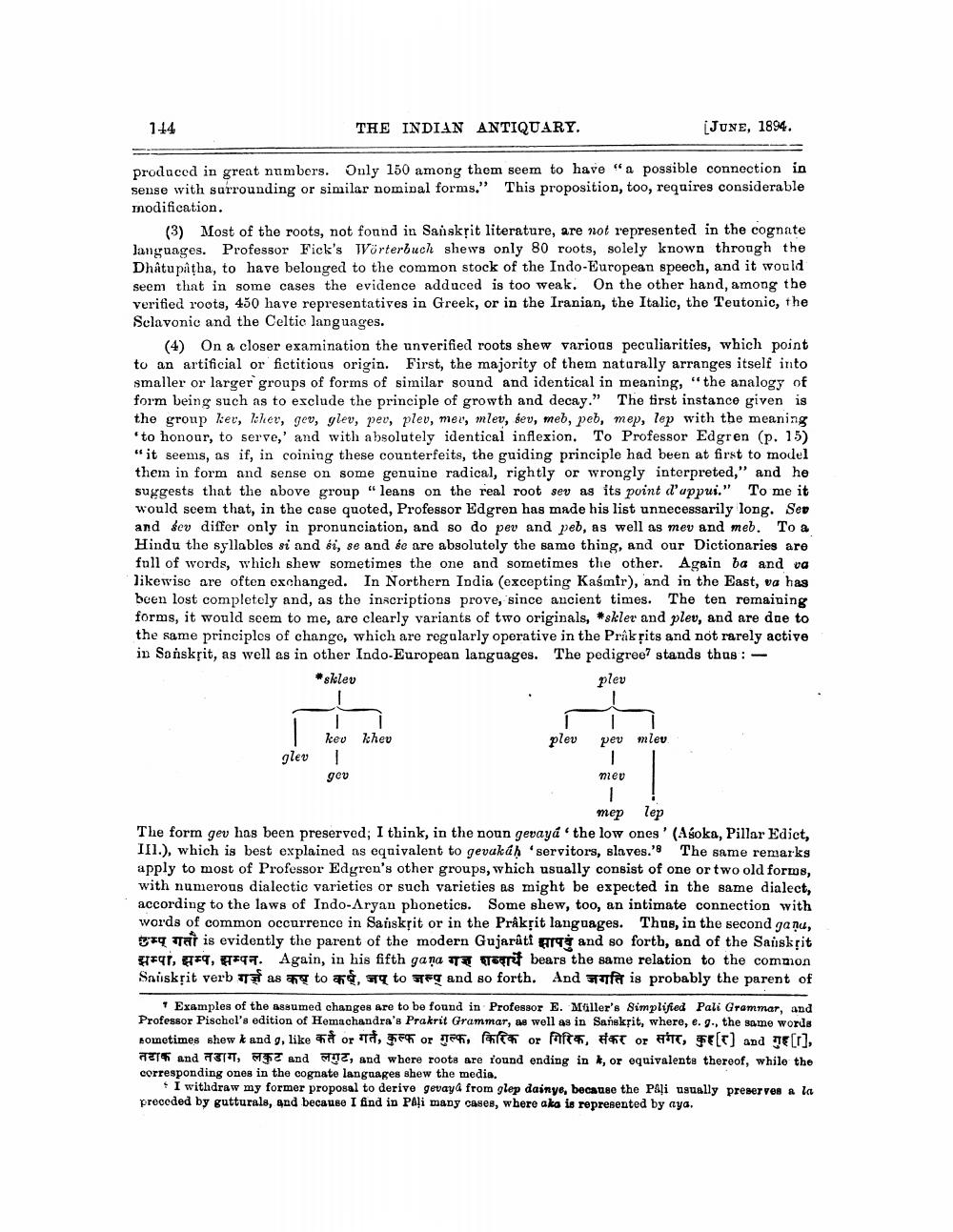________________
144
THE INDIAN ANTIQUARY.
[JUNE, 1894.
produced in great numbers. Only 150 among them seem to have "a possible connection in sense with surrounding or similar nominal forms." This proposition, too, requires considerable modification.
(3) Most of the roots, not found in Sanskrit literature, are not represented in the cognate languages. Professor Fick's Wörterbuch shews only 80 roots, solely known through the Dhatupatha, to have belonged to the common stock of the Indo-European speech, and it would seem that in some cases the evidence adduced is too weak. On the other hand, among the verified roots, 450 have representatives in Greek, or in the Iranian, the Italic, the Teutonic, the Selavonic and the Celtic languages.
(4) On a closer examination the unverified roots shew various peculiarities, which point to an artificial or fictitious origin. First, the majority of them naturally arranges itself into smaller or larger groups of forms of similar sound and identical in meaning, "the analogy of form being such as to exclude the principle of growth and decay." The first instance given is the group ker, hev, gev, glev, pev, plev, mer, mlev, sev, meb, peb, mep, lep with the meaning 'to honour, to serve,' and with absolutely identical inflexion. To Professor Edgren (p. 15) "it seems, as if, in coining these counterfeits, the guiding principle had been at first to model them in form and sense on some genuine radical, rightly or wrongly interpreted," and he suggests that the above group "leans on the real root sev as its point d'appui." To me it would seem that, in the case quoted, Professor Edgren has made his list unnecessarily long. Sev and sev differ only in pronunciation, and so do pev and peb, as well as mev and meb. To a Hindu the syllables si and si, se and śe are absolutely the same thing, and our Dictionaries are full of words, which shew sometimes the one and sometimes the other. Again ba and va likewise are often exchanged. In Northern India (excepting Kaśmir), and in the East, va has been lost completely and, as the inscriptions prove, since ancient times. The ten remaining forms, it would seem to me, are clearly variants of two originals, *skler and plev, and are due to the same principles of change, which are regularly operative in the Prakrits and not rarely active in Sanskrit, as well as in other Indo-European languages. The pedigree stands thus: -
*sklev
plev
glev
T
kev khev
I gev
plev
pev mlev I
mev
1
mep lep
The form gev has been preserved; I think, in the noun gevaya' the low ones' (Aśoka, Pillar Edict, III.), which is best explained as equivalent to gevakáḥ 'servitors, slaves.'s The same remarks apply to most of Professor Edgren's other groups, which usually consist of one or two old forms, with numerous dialectic varieties or such varieties as might be expected in the same dialect, according to the laws of Indo-Aryan phonetics. Some shew, too, an intimate connection with words of common occurrence in Sanskrit or in the Prakrit languages. Thus, in the second ganu, at is evidently the parent of the modern Gujarati and so forth, and of the Sanskrit झम्पा, झम्प, झम्पन. Again, in his fifth ganart bears the same relation to the common Saiskrit verb गर्ज़ as कष् to कर्ष, जप् to जरूप and so forth And जगति is probably the parent of
Examples of the assumed changes are to be found in Professor E. Müller's Simplified Pali Grammar, and Professor Pischel's edition of Hemachandra's Prakrit Grammar, as well as in Sanskrit, where, e. g., the same words sometimes shew k and g, like कर्ते or गर्त कुल्फ or गुल्फ, किरिक or गिरिक, संकर or संगर, कुह[र] and गुह[[], तटाक and तडाग, लकुट and लगुट, and where roots are found ending in k, or equivalents thereof, while the corresponding ones in the cognate languages shew the media.
I withdraw my former proposal to derive gevaya from glep dainye, because the Pali usually preserves a la preceded by gutturals, and because I find in Pali many cases, where aka is represented by aya.




